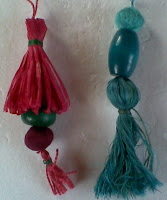
 Making a series of tassels provided an indulgent activity over the festive period, made more enjoyable by finding these objects while I was away. These acorn or thistle tassels provided a wonderful pastel, faded tapestry cushion with a splendid edging where some tassels had burst open. I set out to replicate this in 3.6.2.
Making a series of tassels provided an indulgent activity over the festive period, made more enjoyable by finding these objects while I was away. These acorn or thistle tassels provided a wonderful pastel, faded tapestry cushion with a splendid edging where some tassels had burst open. I set out to replicate this in 3.6.2.Setting out to combine a range of tassels in colour groups the results show:

 Ref 3.6.1 from left to right
Ref 3.6.1 from left to right Rayon thread wrapped round free machine stitched fabric toggles
Tapestry wool and ribbon
Tartan turks head withfrayed centre tassel
Ref 3.6.2
Realised how much thread was used on acorn tassel -mine look skinny in comparison could there been a hidden kernel in the centre?
Ref 3.6.3 a
 This shows how I used up loose threads to make beads that could be used as shown in 3.6.4. Thanks to Alma Stoller for this tip. Could these be used to make a 'soft centre' to a tassel and reduce the amount of thread needed for the tassel?
This shows how I used up loose threads to make beads that could be used as shown in 3.6.4. Thanks to Alma Stoller for this tip. Could these be used to make a 'soft centre' to a tassel and reduce the amount of thread needed for the tassel? Ref 3.6.3b gives the answer, not an easy task, tried to knot the tread to increase bulk. Putting bead in middle of small tassel proved very fiddly on this scale. Think I will just have to go for slightly thicker thread and uses lots of it!
Using wooden beads, handmade beads, glass beads, wrapped rings and champagne cork to add interest to the tassels
Ref 3.6.4 a Ref 3.6.4.b
The green tassel is made from silky thread
The yellow tassel, 3.6.4 b is pulled through a sellotape cardboard template which has been wrapped in sari yarns and is topped with coloured silk cocoon. The body of the tassel includes tapestry wool, metallic cord
Seed beads threaded onto rayon thread with metallic thread used to make a cap and loop.
Initially I was disappointed that this tassel settled into two 'legs' as the beads seemed to
wind around each other and seperate it rather than going into a cleaner line.
Its beginning to appeal, perhaps it would look better if the method was used on a shorter tassel
Ref 3.6.4 d
A champagne cork provides the mould for the top which was covered with fabric made from threads which had been machine stitched to soluble fabric. Two fabric skirts were added. It looks a bit heavy handed so maybe it should be called 'morning after the night before '!!
Making a looped head for a tassel
Ref 3.6.7 a
 Ref 3.6.7 b keeping the cord uncut and trying to wrap the bunch proved ackward and slippy. Ref 3.6.7 c, below, even wrapping the bundle was difficult to keep wrap threads from slipping when yarn was bent over
Ref 3.6.7 b keeping the cord uncut and trying to wrap the bunch proved ackward and slippy. Ref 3.6.7 c, below, even wrapping the bundle was difficult to keep wrap threads from slipping when yarn was bent over  Ref 3.6.7 d Ref 3.6.7 e
Ref 3.6.7 d Ref 3.6.7 e 
The metallic threads for all samples were wound over a metal frame and free machine embroidery was used . Samples 3.6.8a were knotted and twisted Heavy machining was done on samples 3.6.8.b right hand sample and samples 3.6.8c I found it easier to use a zig zag stitch in line with the threads rather than a straight stitch at a 90 degree angle.
Ref 3.6.8 a Ref 3.6.8 b Ref 3.6.8.c
For a reference point to some of my other work I have included this upside down tassel which was made for a project on small baskets made from thread. This sample shows twining threads of string with linen and then unwinding the string to make the 'burst'.











No comments:
Post a Comment